The AMD Threadripper 2 CPU Review: The 24-Core 2970WX and 12-Core 2920X Tested
by Ian Cutress on October 29, 2018 9:00 AM ESTGaming: Shadow of the Tomb Raider (DX12)
The latest instalment of the Tomb Raider franchise does less rising and lurks more in the shadows with Shadow of the Tomb Raider. As expected this action-adventure follows Lara Croft which is the main protagonist of the franchise as she muscles through the Mesoamerican and South American regions looking to stop a Mayan apocalyptic she herself unleashed. Shadow of the Tomb Raider is the direct sequel to the previous Rise of the Tomb Raider and was developed by Eidos Montreal and Crystal Dynamics and was published by Square Enix which hit shelves across multiple platforms in September 2018. This title effectively closes the Lara Croft Origins story and has received critical acclaims upon its release.
The integrated Shadow of the Tomb Raider benchmark is similar to that of the previous game Rise of the Tomb Raider, which we have used in our previous benchmarking suite. The newer Shadow of the Tomb Raider uses DirectX 11 and 12, with this particular title being touted as having one of the best implementations of DirectX 12 of any game released so far.
| AnandTech CPU Gaming 2019 Game List | ||||||||
| Game | Genre | Release Date | API | IGP | Low | Med | High | |
| Shadow of the Tomb Raider | Action | Sep 2018 |
DX12 | 720p Low |
1080p Medium |
1440p High |
4K Highest |
|
All of our benchmark results can also be found in our benchmark engine, Bench.
| Game | IGP | Low | Medium | High |
| Average FPS | 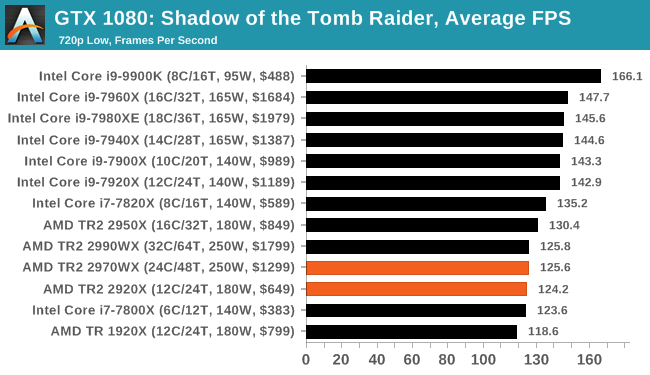 |
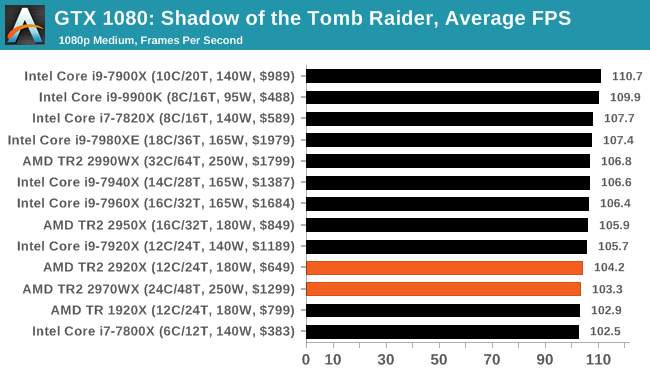 |
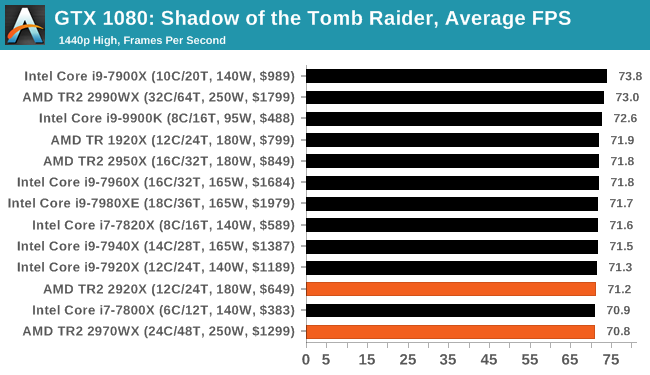 |
 |
| 95th Percentile | 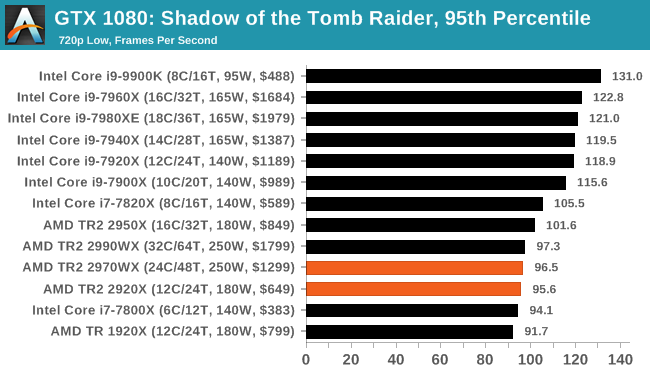 |
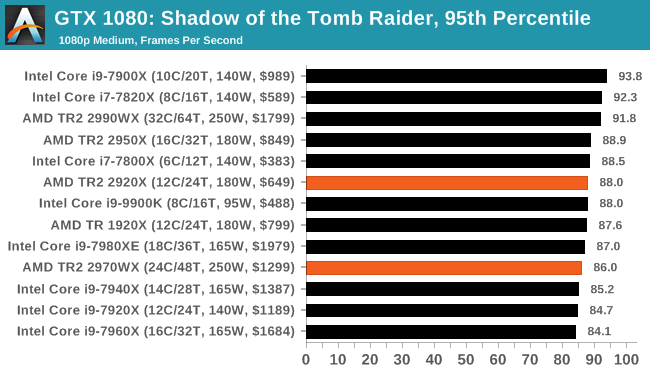 |
 |
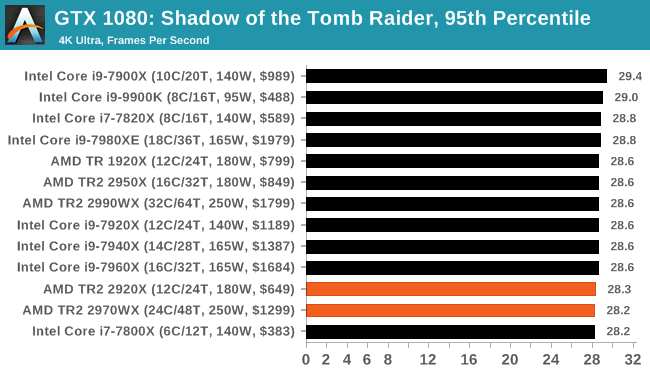 |












69 Comments
View All Comments
The Hardcard - Monday, October 29, 2018 - link
I am not clear on this: can I get a 4-active-die TR for rendering and then turn off the 2 parasite dies when they are a disadvantage. Say make the 2990X operate as a 2950X with the same performance and power?I am not clear if that is what the dynamic local mode is offering. I’d like to be able to do that, whether there is an official AMD path, or if the community finds another way.
BikeDude - Monday, October 29, 2018 - link
<blockquote>Please note, if you plan to share out the Compression graph, please include the Decompression one. Otherwise you’re only presenting half a picture.</blockquote>Many moons ago I made a request to internal IT to adopt 7-zip so that I could save on bandwidth whenever I needed to pull a largish database (this was several years before GDPR obviously).
No go. It turned out that compressing the backups every night eats a lot of time. (decompressing these files was very fast regardless of setup) Well, actually they did use 7z.exe, but only as a normal zipper.
So sometimes the only relevant part of the equation is the compression time. (I do plan on purchasing AMD regardless for my next upgrade)
GreenReaper - Wednesday, October 31, 2018 - link
Use a threading-capable version of xz with the -T parameter so it uses all available threads and you'll find it flies on the default compression settings. It has a Windows version, too: https://tukaani.org/xz/GreenReaper - Wednesday, October 31, 2018 - link
Incidentally, you can probably run it something like xz < "input command" > output.xz, which should mean you don't actually have to write the dumps out, just the compressed version.PaoDeTech - Monday, October 29, 2018 - link
I need 13 cores and 26 threads. Now what? I returned the 32 cores 64 threads one since it could not run FAR CRY at 60fps. But boy could it blend! Sarcasm aside, I write multi-threaded server software and unless I code an infinite loop by mistake (I'm NOT admitting to it) I can never max out 8 threads before hitting I/O limitations (on NVMe PCIe disk). But I can see how some number crunching parallel software would go to town with it.peevee - Wednesday, October 31, 2018 - link
"I can never max out 8 threads before hitting I/O limitations (on NVMe PCIe disk)"Do you know these are IO limitations or do you assume this? Because lack of scaling after 8 threads does not mean IO limit at all. For example, if you write in Java/C#/Python/JS etc (heap-mandatory languages), or even use heap alloc/dealloc in critical thread sections in fast languages like C++, this is what you are going to get (heap mutex = no scalability). And this is just 1 of a thousand pitfalls of massive threading.
PaoDeTech - Thursday, November 1, 2018 - link
No locks, every client call gets its own thread (REST- IIS -WebAPI -.NET "stateless" server - Entity Framework - SQL Server with read committed snapshot isolation). Async all the way down. Under load I can see the disk active >50% and write speed maxes out at 7 MB/s (Toshiba NVMe PCIe 1TB SSD M2). All processes running on the same PC (i7 6700k - 32GB RAM): server, test clients, SQL server. Plenty of free ram.Of course performance optimization is in the details and I was referring to a specific write intensive test case. My point is that parallel scaling is not easy and may stop sooner than expected (for many reasons). On the other hand, I can always use faster single thread performance...
29a - Monday, October 29, 2018 - link
Please replace EgoMark (3DPM) with something else, anything else.danjw - Monday, October 29, 2018 - link
Are there any motherboards out there that support the security features of the Threadripper platform?SLVR - Monday, October 29, 2018 - link
This review is a bit more useful: https://www.techspot.com/review/1737-amd-threadrip...